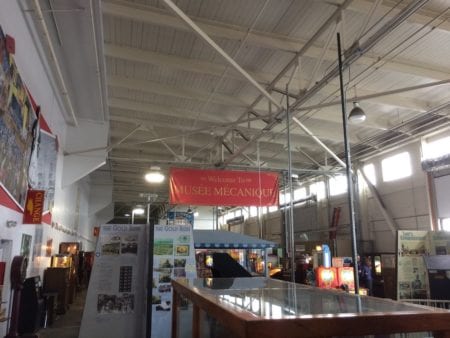From the confines of his workshop, Dan Zelinsky, a spry 65 year-old dressed in a full denim getup, tilts his head toward the commotion of Musée Mécanique’s warehouse floor.
“Wow, weird,” he says, turning to his colleague, Ken Eaton, who assists with repairs. “Did you hear that hiccup? The keyboard just stopped in the middle.”
Zelinsky steps to his live feed of the museum floor to check for any on-the-ground clues. From what he can hear, and now see, the machine seems to have returned to normal operation.
“There’s a lot of that,” he says, relaxing a bit. As the owner of one of the largest collections of coin-operated art in the world — and the largest that’s open to the public — Zelinsky has to be ready to make a repair at any moment.
Loud Music, Laughing Monsters
Musée Mécanique is stationed in a 9,300-square-foot warehouse overlooking the San Francisco Bay, beyond the street vendors and chowder stands of the city’s iconic Fisherman’s Wharf. Admission is free, drawing throngs of tourists who are eager to play more than 300 coin-operated musical and animatronic experiences, from ’80s arcade games to bizarre tableaus of 19th century American life.
The oldest machine, at least on paper, is an 1884 Praxinoscope, an early animation device. The collection’s most recent addition is a 1915 Wurlitzer band organ, and Zelinsky is pretty excited about it.

Dan Zelinsky stands with his 1915 Wurlitzer band organ.
“Best thing ever!” he shouts above the machine’s martial blare. “Used at the middle of the merry-go-round!”
The most famous? Probably Laffing Sal, for reasons that Zelinsky sums up nicely: “She’s, you know, this big, dominating, six-foot mechanical carrot top nightmare from hell in a lot of people’s opinion, so it’s pretty hard to forget that.”
From a Basement to the Bay

Visitors stare at Laffing Sal, the museum’s most well-known attraction.
The collection, housed at the wharf since 2002, started in the basement of Zelinsky’s childhood San Francisco home, where his father, Ed Zelinsky, kept an eclectic mix of antique games and musical instruments. In 1968, the elder Zelinsky bought the arcade portion of the long-gone seaside amusement park Playland-at-the-Beach. Four years later, he hired his then 20-year-old son to help him full-time with the museum’s maintenance and operation.
She’s, you know, this big, dominating, six-foot mechanical carrot top nightmare from hell in a lot of people’s opinion, so it’s pretty hard to forget that. — Dan Zelinsky describing the museum’s most infamous resident, Laffin Sal.
Visitors from all over the country come to Zelinsky with stories from childhood summers spent exploring the bowels of San Francisco’s Cliff House, where the collection was formerly held. Today, as Zelinsky clambers into the arcade game “Down the Clown” to reattach one of the stuffed, red-nosed targets, a museum-goer from New Orleans approaches him.

“I used to go to the museum on the cliffside,” he tells Zelinsky. “It’s one of my fondest memories.” Zelinsky lifts his head and smiles.
In the Workshop, A Game Visitors Rarely See
Nose-less clown aside, today is a relatively quiet one, allowing Zelinsky to retreat to a private room surrounded by work tables and tool boxes where he dreams up the new and tends to the old.
“A lot of these machines are well over 100 years old,” he says, “and they don’t work any differently now than they did when they were new.
“The only thing different is the parts department is gone,” which means that Zelinsky is on his own when it comes to the frequent repairs, criss-crossing the crowded museum floor in roller skates to attend to ailing machines as problems arise.

Dan Zelinsky, wearing his “I work here” badge, stands with his Bridgeport vertical mill.
With his 1948 LeBlond lathe and 1966 Bridgeport vertical mill — the only machine, Zelinsky says, that can reproduce itself by fabricating each of its parts — Zelinsky fashions replacement gears and knobs, handles and wheels, everything that eventually succumbs to the decades of constant wear.
“Parts I can’t find, I can make right here,” he says.
 Zelinsky installs windows in the backs of some machines so that children can observe the mechanics behind Ride ’em Cowboy, say, or the National Player Piano. Other private collectors lecture Zelinsky on the risks of keeping his collection open to the public. While impatient visitors have caused serious damage — and ignited in Zelinsky serious frustration — he wouldn’t consider locking up his toys.
Zelinsky installs windows in the backs of some machines so that children can observe the mechanics behind Ride ’em Cowboy, say, or the National Player Piano. Other private collectors lecture Zelinsky on the risks of keeping his collection open to the public. While impatient visitors have caused serious damage — and ignited in Zelinsky serious frustration — he wouldn’t consider locking up his toys.
“The fact that this stuff still exists, and that the public can still be exposed to it, I think it’s not just important — it just serves too many purposes.”
Legacy and Community

Though Zelinsky’s sons, both in their twenties, won’t take over the family business as Zelinsky did, he doesn’t plan to scale back. He’s always on the lookout for new contraptions, and given Musée Mécanique’s fame in the world of antique machines, he gets calls from sellers all the time.
“Once you get into anything,” he says, “whether it’s sewing, or cycling or whatever, all the sudden you meet people who are just dedicated to that. That stands true for this, as well.”
The procurement, creation, and upkeep of all these machines, each composed of literally hundreds of moving parts, means that Zelinsky’s work can never really end. So when the crowds thin for a moment, Zelinsky takes the time to reflect on his fortune.
“Usually I’m on roller skates and I’m just flying. But we got a really peaceful morning. It’s nice!”
Images courtesy of Will Callan


Share this: